
Stellaris – Review
You might have seen it sitting snugly in the Steam top sellers list. A grand 4X space strategy game from celebrated strategy developers Paradox. If you’ve ever wanted to explore the stars, meeting new friends and allies along the way, or just enslave and subjugate every species that you meet, in order to declare yourself the emperor of the galaxy, here is your opportunity. Stellaris has arrived.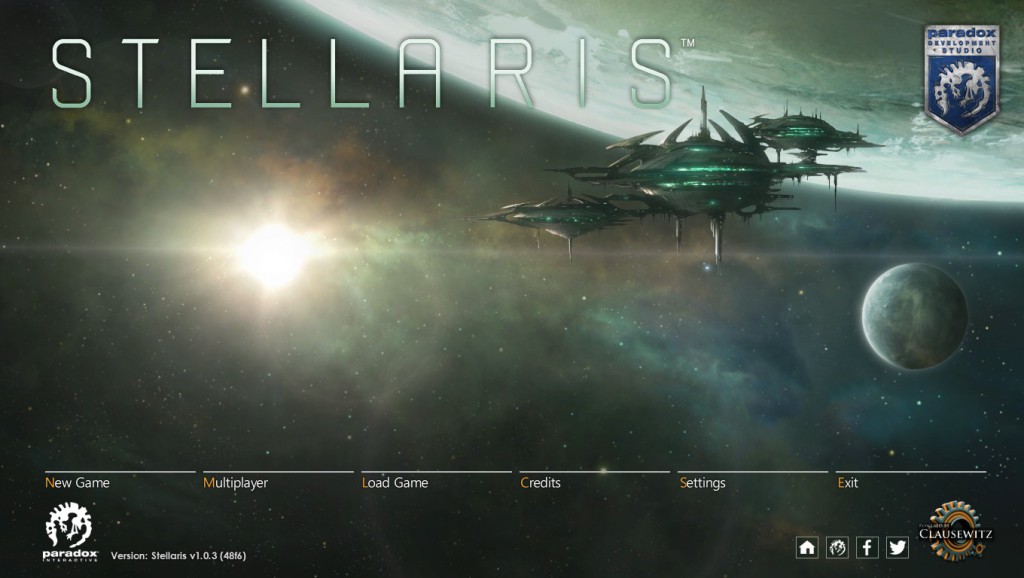 Story
Story
As you might expect, story does not play a typical role within a large strategy epic such as this. If you are at all familiar with grand strategy, or 4Xs in particular, then you will know that you are usually left to your own devices, and ultimately end up creating the story yourself. Whether that’s the story of how you defeated your greatest enemy; Gandhi in Civ V, or the story of how you became a savior, by freeing all of the slaves from their evil slug overlords. Stellaris appears to follow this rule too, yet has some fantastic little tricks up its sleeve.
Stellaris utilises the Event system as a great way of introducing little storylines into the game for you to deal with. Whether it’s a group of religious fanatics that have stolen some of your vessels and flown off into deep space, or you have discovered the remnants of an ancient pre-courser civilization, the event system integrates these experiences into your playthrough and you must choose how you wish to deal with them, often creating whole branching storylines from your choices and actions. Although the down side is that currently the number of events is fairly limited, so you will see the same ones begin to appear again and again within a few playthroughs.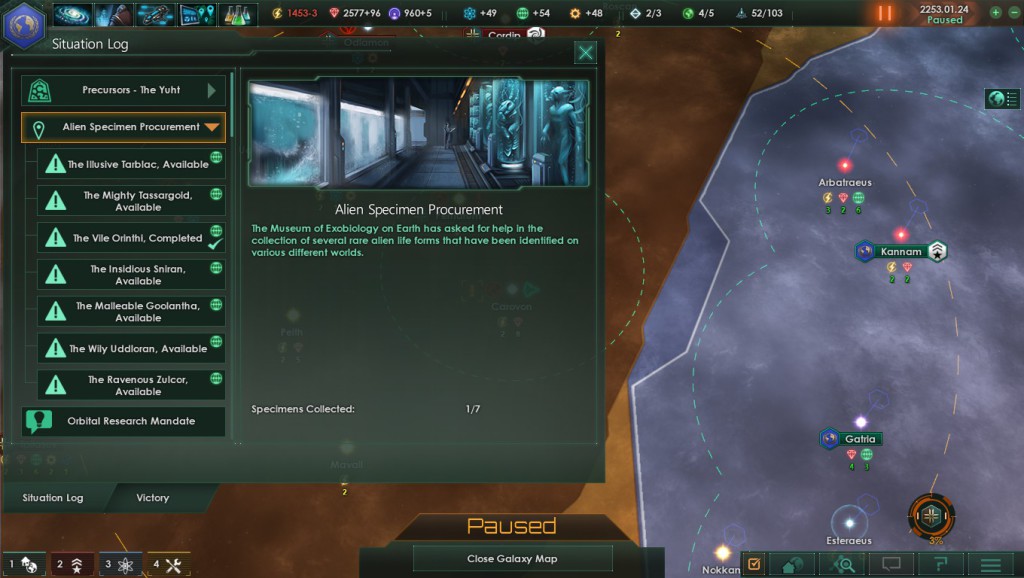 Graphics
Graphics
The graphics themselves are beautiful, expect to see everything from neutron stars to black holes and massive nebula’s lovingly rendered. You can also zoom right in to see the most minor details such as your ship’s armaments or your little mining stations at work. Likewise the UI is crisp and rather simple for what you would expect from Paradox, although not without its flaws.
With all this at work, space battles become a sight to behold (if somewhat of a clusterfuck later in the game). You can see your ships in action, the turrets rotating, the cascade of nuclear missiles, the flare of lasers slicing through the enemy fleet and shells flying across the screen.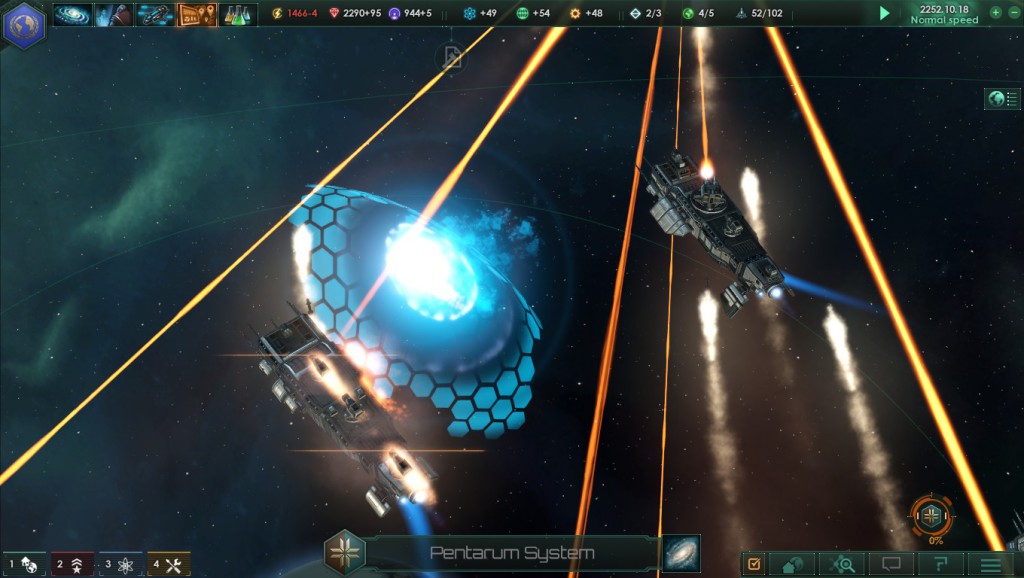 Sound
Sound
The sound, and particularly the music for Stellaris has to be spot on. As any strategy fan will know, the last thing you want in a game like this, where you will likely be putting in untold hours of your life, is to have to turn the sound off because the music or effects are too annoying or immersion breaking.
Sound in this respect, is often overlooked when it can actually be one of most useful and defining tools in a developers arsenal. Thankfully, the quality of the sound and the music in Stellaris is exceptional and actually helps you immerse yourself in the game, and after more than 20 hours of play we are yet to find any of it annoying or unsuitable. Gameplay
Gameplay
Stellaris follows a similar path as most space strategy games in that you are put in control of a burgeoning space empire and must expand and explore the galaxy in order to ultimately become its conqueror. This is most of what the early game consists of. Expect to fall in love quickly and be oohing and ahhing with every new horizon that you cross.
Soon however you will find yourself in the mid game where you have explored all your immediate territory and now find yourself hemmed in by other civilizations with not a whole lot to do. This is currently one of the biggest complaints that we are hearing and the reason that a lot of players get bored, start again, and never experience the end game. This is something that Paradox themselves have acknowledged and plan to release more content for in the coming months.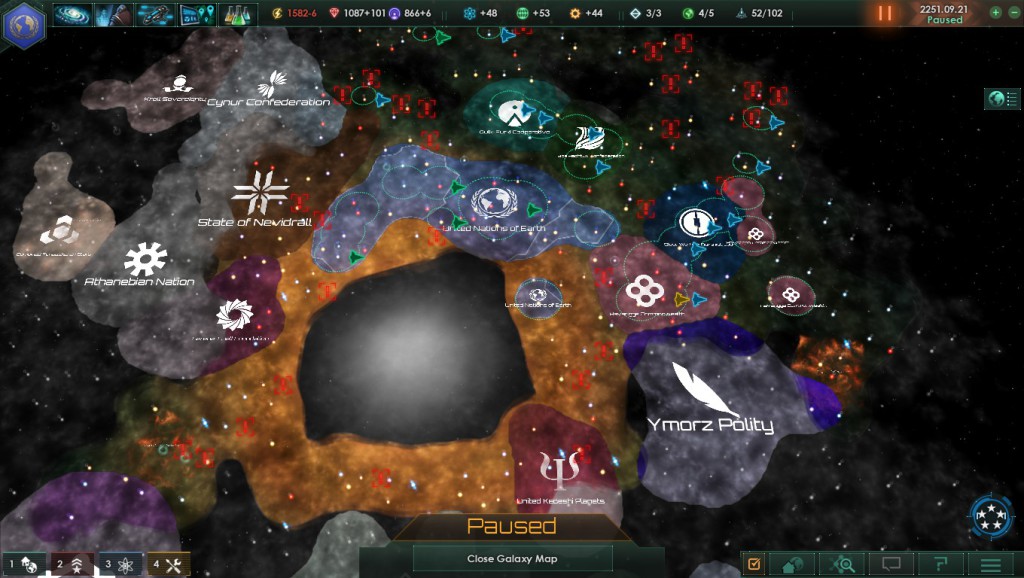 If you make it through, the late game is where you will find huge space battles between large alliances and federations and also where you will see the event system come back into play more prominently with the late game Crisis. Researching and using certain technologies may cause a galactic crisis that can destroy the whole galaxy if left unchecked. These events range from an AI led robotic uprising, to powerful invaders from another plane of existence that want your galaxy all for themselves.
If you make it through, the late game is where you will find huge space battles between large alliances and federations and also where you will see the event system come back into play more prominently with the late game Crisis. Researching and using certain technologies may cause a galactic crisis that can destroy the whole galaxy if left unchecked. These events range from an AI led robotic uprising, to powerful invaders from another plane of existence that want your galaxy all for themselves.
The UI has a pretty nifty inbuilt tutorial which will walk you through some of the basics and starter events, but you will still have to figure out quite a lot for yourself. The UI itself is excellent in places, but will let you down by displaying minimal information in others. Expect to have to sift through lots of useless information or count manually to be able to find the information that you need. For example, after a battle you are presented with a little synopsis that tells you how much damage you dealt and your accuracy etc. However it fails to give you any useful information like how many of your ships were destroyed or how. This missing essential information becomes extremely frustrating, particularly when it comes to sectors.
Sectors are a good solution to late game micro-management. The problem you often get with large space strategies like this is that by the end game you have too many planets to keep track of and micro-manage. Sectors are aimed to combat this. You designate a group of planets as a sector and set one of your leaders as its governor and voilà, the AI does all the hard work for you. The idea is that you will never personally have to manage more than 5 planets at a time, but what it doesn’t take into account is that the AI is absolutely terrible at managing planets.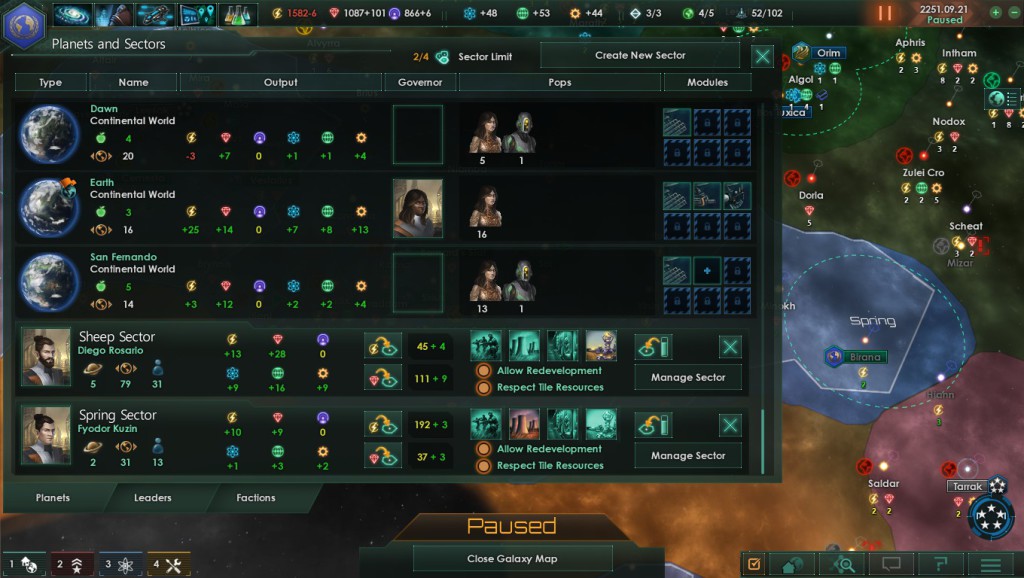 The only way that this works is if you put a brand new planet, that you have just settled, into the hands of the AI and let it do its thing. If you try it with a planet that you have lovingly cultivated and grown then expect to see the AI ruin everything that you worked so hard on.
The only way that this works is if you put a brand new planet, that you have just settled, into the hands of the AI and let it do its thing. If you try it with a planet that you have lovingly cultivated and grown then expect to see the AI ruin everything that you worked so hard on.
Another problem is that it’s unclear what you still have to control. The AI only controls the planets surface and building queue and you are not allowed to intervene, but you are not informed that each planets spaceport is still in your hands. You still have to do all your ship building and recruiting of armies manually, except all the spaceports are removed from the UI when you add them to a sector. So the only way to find them in to trawl across the galaxy and click on each one individually.
Technology functions quite differently from most titles in this genre. You don’t have a tech tree like most games, instead you are given a selection of random techs, shuffled out to you like cards. This has tremendous upsides in that it adds fantastic replayability and makes each playthrough unique, something sorely lacking in similar 4X space strategies. The downside is that you are often offered things that you are unsure if you want or need and by the mid-late game you have most of the important techs and are just grinding all the others for the +5% bonus that they give you.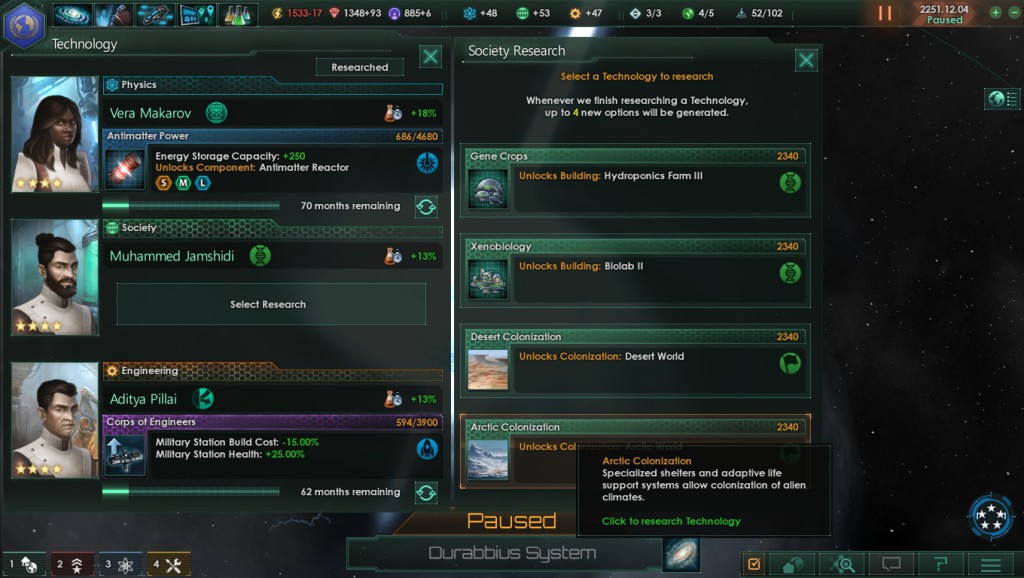 Once you’ve researched an exciting new technology you are going to want to put it to use. This is where the ship design screen comes in, you are able to build your own vessels from the ground up. You choose the modules that make up each vessel and then assign whatever you want into those slots. If you want to concentrate on shields, then you can pile in lots of power generators and shield emitters, or else you can heavily armour your ship and give it the ability to rapidly heal itself automatically, or make it a mix of the two. Experiment with all the weapons that the game can offer and fit them to your ships as you see fit.
Once you’ve researched an exciting new technology you are going to want to put it to use. This is where the ship design screen comes in, you are able to build your own vessels from the ground up. You choose the modules that make up each vessel and then assign whatever you want into those slots. If you want to concentrate on shields, then you can pile in lots of power generators and shield emitters, or else you can heavily armour your ship and give it the ability to rapidly heal itself automatically, or make it a mix of the two. Experiment with all the weapons that the game can offer and fit them to your ships as you see fit.
War isn’t always the answer however, there is also a diplomacy system that has some fantastic features, but also suffers from a frustratingly stupid AI. Races all have an ethos, a set of beliefs that they follow, which is great and makes them more friendly to those who hold similar values. This can be crucial in finding friends within the realm of deep space. However the AI is entirely unbending, nobody will trade anything with you if they don’t like you or your ethos, particularly not access rights through their space. So you will often find yourself hemmed in by neighbouring empires, blind to the rest of the galaxy. Likewise the AI is so stubborn that even during a galactic crisis, when the whole galaxy is being destroyed, they will refuse to let you through their space to help save them.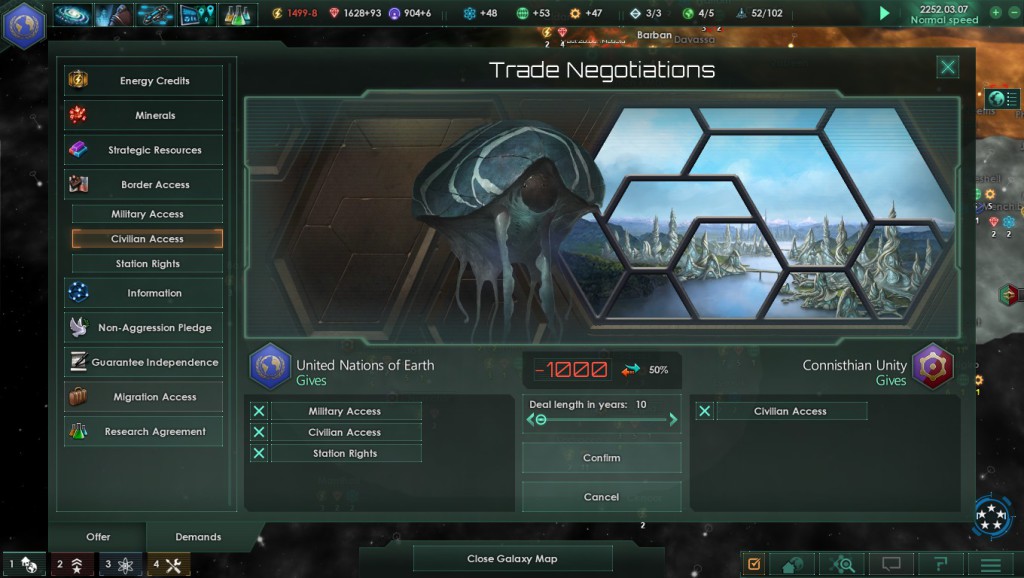 Each of the races are procedurally generated, which is nice for replayability (you never know who you’re going to meet), but also means that the races all severely lack personality. Whether they look like lizards or slugs or mushrooms it does not matter, all the opposing races are essentially the same. They all have the same needs and resource requirements, plus a randomly generated ethos. There are no unique buildings or requirements for each race, nobody lives in caves or on mountains, and each races attributes are entirely random. Which doesn’t really cut it when these species are supposed to be completely alien.
Each of the races are procedurally generated, which is nice for replayability (you never know who you’re going to meet), but also means that the races all severely lack personality. Whether they look like lizards or slugs or mushrooms it does not matter, all the opposing races are essentially the same. They all have the same needs and resource requirements, plus a randomly generated ethos. There are no unique buildings or requirements for each race, nobody lives in caves or on mountains, and each races attributes are entirely random. Which doesn’t really cut it when these species are supposed to be completely alien.
Conclusion
Stellaris has a hell of a lot of good things going for it. The technology and event systems are fantastic and help make this one of the best space RTS’s that we have ever played. And whilst it does have its share of negatives, the developers have already promised to address the majority of them. This, along with the growing library of mods that are becoming available, means that Stellaris is never going to be short of content, and is destined to become a fan favourite for a long time.
6 Comments
Leave a Reply
You must be logged in to post a comment.














[…] Stellaris is a strategy game with a galactic scope, just like on our tiny planet different factions battle it out in space for total control. Soon another contender will set foot in this galactic arena. As is to be expected in a futuristic space game Artificial Intelligence will start leading its own life and create a civilization solely inhabited by machines. In no time they will expand their reach to the far corners of the galaxy. Fans can look forward to seeing this story pack pop up on their Windows, Mac and Linux PCs later this year. Interested but not convinced? Check out our review of the original game here. […]
[…] Today Paradox Interactive proudly announces Synthetic Dawn, a new Story Pack for Stellaris that will add another contender for galactic domination. A.I. controlled machines should be included in any self respecting sci-fi game, book or movie. It’s time for the machines to rise up and form their own societies and find a place among the stars. Whether or not this will go peacefully is an entirely different question. Of course it will not go peacefully so better chain watch Terminator, Battlestar Galactica and I, Robot. You can read our review of the original game right here. […]
[…] For those not familiar with the game Stellaris, it’s a sci-fi strategy game in which you attempt to forge your very own galactic empire. The galaxy is inhabited by many different species, some more humanoid than others. Paradox Interactive is now announcing the release of the Humanoids Species Pack, for the small price of $7.99 (or regional equivalent) you’ll be able to get several cosmetic upgrades to both character portraits and ship models from the human race. The pack will also include voiceovers for the VIR and several remixed songs of the original soundtrack. You can find our review of the original game right here. […]
[…] The universe is a big place with too many planets, so Paradox Interactive, publisher and developer of Stellaris decided to add some more humanoids to cause chaos and destruction. The Humanoids Species Pack will add plenty of purely cosmetic content to the ever expanding game Stellaris. With new species portraits, ship models, music tracks, and voice sets for VIR, the game will feel fresh once more. If you’re interested in finding out more about the game, check out our review here. […]
[…] The ever expanding universe of Stellaris is receiving another update. The expansion named Apocalypse will be available February 22, 2018. Inevitable doom is coming to this sci-fi empire destroying strategy game in the form of planet killing weapons like the well known Death Star from Star Wars. There will also be plenty of smaller offensive and defensive new options including some nonviolent ones. Alongside the payable expansion, the game will also receive several new free features giving all players a better chance for survival in the form of a badly positioned exhaust vent which leads directly to the core of the super weapon. You can find our review of the original game right here. […]
[…] Paradox Interactive and Tantalus Media are proud to announce the upcoming release of Stellaris: Console Edition. As you might have guessed from the game’s title, the game was previously already available on PC and is now making its way to consoles at warp speed. Stellaris is a Sci-Fi grand strategy game and those games typically benefit from keyboard and mouse as input devices. The developers are intent on making a successful expansion to consoles and have put a lot of work into adapting the interface to accommodate controllers as the main input device. One thing is for sure, space will be looking great on TV. You can find our review of the original PC game right here. […]